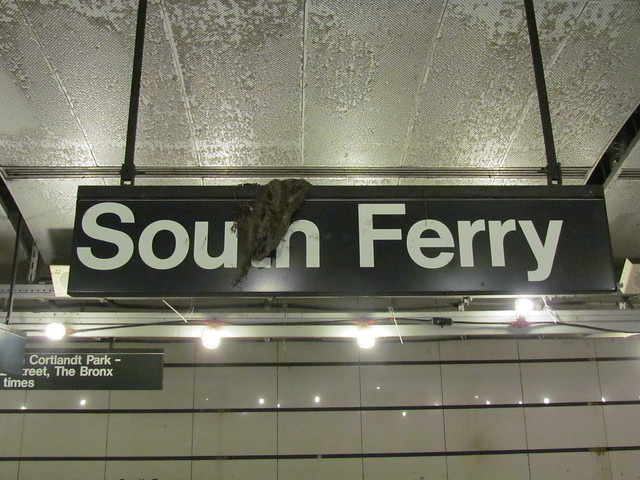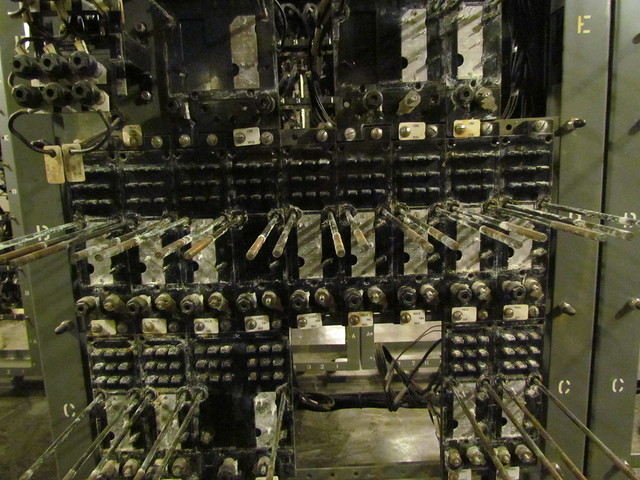
Water filled even the overpass above the 1 train’s terminal tracks at South Ferry. (Photo by Benjamin Kabak)
In Lower Manhattan, a very expensive problem is brewing. The 1 train’s South Ferry Station, essentially totaled by flooding from Sandy, is in very bad shape, and the MTA estimates that fixing the damage caused to this terminal and the electrical infrastructure will cost $600 million. After years of supporting overpriced subway expansion, New Yorkers are finally experience subway sticker shock as many are questioning the wisdom of rebuilding South Ferry as it was.
When the House passed the Sandy relief package a few days ago, the question probably became a moot one. After all, the MTA will get its $600 million in federal funds it has earmarked for the project, and although my tour of the station last week revealed just how much work hasn’t been done to clean up the station, with money on hand, the MTA can begin assessing the damage and bidding out contracts for the restoration effort. Still, it’s worth examining a few arguments for and against. In the grand tradition of the Internet, there’s a poll at the end of this post.
The Argument Against Rebuilding
1. It’s too darn expensive.
It didn’t make sense to spend $545 million to build a new South Ferry station in the first, and it certainly doesn’t make sense to spend $600 million repairing one that just opened four years ago. Even though the money in both cases will have come from the federal government, the final price tag for South Ferry and its rebuild will top $1 billion. Even in today’s age of insanely high-priced capital projects, this dollar amount should give us pause. Is there no better or cheaper solution on hand?
2. Spending $600 million somewhere else.
One counterargument that I don’t address in the post concerns an analogy to the ARC Tunnel. Gov. Chris Christie canceled ARC because he felt, in part, that the money could be better used elsewhere. Am I making the same argument here? Perhaps so, but if we assume that the dollars are not unlimited, maybe the $600 million would be better used on hardening the subway system or funding capital projects that will encourage people to look away from flood-prone areas of the city. We can spend this $600 million in a way that doesn’t strain more resources in vulnerable neighborhoods.
3. It’s just going to flood again.
For many reasons — including the fact that it just hasn’t been quite long enough to look ahead — the MTA has been mum on how it will spend $600 million. Does this plan include enough station hardening and infrastructure protection? Aren’t we just rebuilding a station that will flood again in the next major hurricane and the next major storm surge? How many times can we the taxpayers expect to foot the bill for a station reconstruction after natural disasters floods the same area over and over again?
4. What about those other nearby stations?
The R train still stops at Whitehall St., and the 1 train’s Rector St. station is a four-block walk from South Ferry. Plus, the 4 and the 5 are right there at Bowling Green. West Side-bound riders can either take the R or walk to the 1, and those heading to the East Side didn’t need South Ferry anyway. These nearby stations should be enough to shoulder the load if South Ferry doesn’t reopen again, right?
The Argument For Rebuilding
1. Access to the Staten Island Ferry Terminal
Despite those nearby stations I just mentioned, the South Ferry stop services a lot of Staten Island Ferry-bound travelers. Prior to Sandy, the station had seen a steady uptick of passengers, and in 2011, over 29,500 people used the South Ferry/Whitehall St. complex on a daily basis. It’s the 33rd busiest station in the system, and the MTA shouldn’t be asking these subway riders to walk another half a mile or so the nearest 1 train station. It’s popular for Lower Manhattan workers, Staten Island residents, Ferry-bound travelers, tourists and everyone in between.
2. Key signal infrastructure and a convenient transfer
The new station features a significant amount of key signaling infrastructure for the old South Ferry loop and the West Side IRT from Rector St. and points south. It may have been folly to leave such vital equipment unprotected, but no matter what happens to South Ferry, it needs to be rebuilt somewhere. Since the electrical infrastructure is a major component of the price, we shouldn’t give up the station for it. Let’s just protect it instead. Plus, we can’t discount the value of an in-system transfer to a train that serves Brooklyn. The 1 and R do not meet again until Times Square, and this transfer point is a vital part of many people’s journeys.
3. The new station adds to 1 train capacity and is ADA-compliant.
With the opening of South Ferry, the MTA could run 24 trains per hour up the 1 line to Van Cortlandt Park. It couldn’t do that with the old loop station, and as this line has seen tremendous growth, especially in Harlem and Washington Heights, we have to maintain train capacity. We also cannot overlook ADA requirements. The new South Ferry was a fully-compliant station, and whatever replaces it would have to be ADA compliant as well. Retrofitting an old station would cost a considerable amount and pose additional engineering challenges.
4. The old South Ferry loop station in bad shape.
I didn’t have the opportunity to take a look at the old station, but it’s in bad shape as well. It too flooded during Sandy, and at a minimum, the signal infrastructure, which was controlled by the room in the new station, would have to be replaced. Overall, that station which hasn’t been in revenue service since early 2009 would need a considerable investment. The gap fillers are gone, capacity is limited, and reactivating it is not as simple as flipping a switch.
So there you have it. This is, of course, a non-exhaustive look at the issues, but it touches on the key concerns. I have major qualms about the final price for the station restoration, but it’s an important terminal that we cannot just discard. If the feds want to pay for a complete rebuild just a few years after funding the original construction, let’s not stop them. What say you?



